The Golden Ships Of Columbus
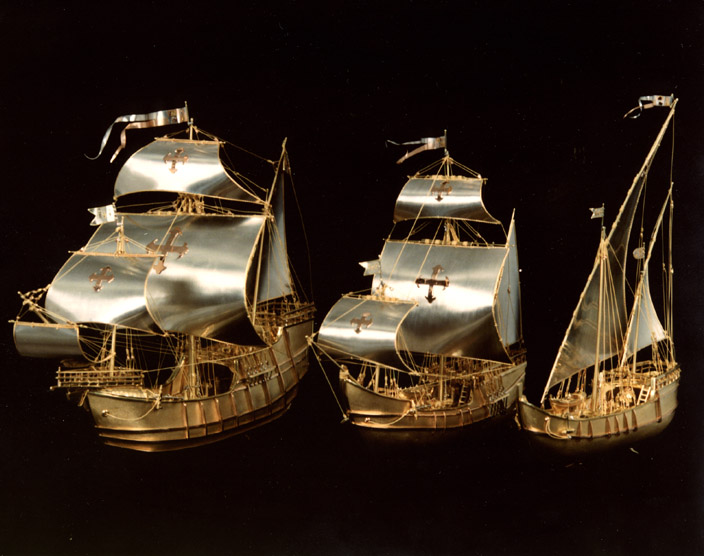
 The Flagship
The Flagship
Antonio took his cues from ship design, not model ship design. This is crucial to an understanding of his work. From the Spanish government, Antonio acquired the blueprints for a reconstruction of Columbus's three ships. Scaled down to a 1-62 scale, the golden ships would correspond exactly to the proportions of the actual ships. The Santa Maria, Columbus's flagship, was a nao-Old Spanish for a large ship-meaning it was for cargo, not exploration. A wide-bodied, somewhat slow craft, its very size nonetheless gave it a sort of grandness. At any rate, it rose to the occasion. It is perhaps the single most famous ship in the history of sailing.
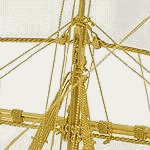 Main Mast
Main Mast
One of the more ingenious touches in the original Santa Maria's design was the main sail's attachment to the mast. This ring-shaped harness holding the boom to the main mast was hollow inside and filled with metal balls that allowed easy movement up and down the mast. Though the sails on these reproductions are of platinum and, thus, frozen in mid-billow, their creator nonetheless remained true to the blueprints and recreated this unusual mechanism. This epitomizes the care with which the Golden Ships of Columbus were made.
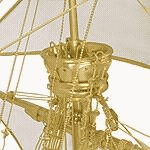 Crow's Nest
Crow's Nest
The Santa Maria wears its crow's nest like a crown. It was certainly a crowning achievement in Antonio's reconstruction of the ship. He built the crow's nest so that it could simply screw onto the top of the main mast. But due to the intricacy-and sheer number-of ropes running through the crow's nest, he could accomplish this only by carefully rotating the entire ship-sort of like turning a whole house to screw in a light bulb. Working in miniature has its own difficulties, and in many ways Antonio's ships were harder to build than Columbus's.
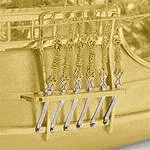
Faithful
The Pinta was a caravel, smaller and sleeker than the Santa Maria, with a good deal less superstructure, making it the faster boat. Faithful to each ship's design, however, Antonio accounted for more than their basic structures. There was the delicacy of the flags and pennants flying over each ship - and the intricacy of the endless lengths of rope. All the ships' ropes were doubled for thickness and then braided, so they required enormous lengths of gold. The Pinta, for example, has 142 feet of gold rope onboard.
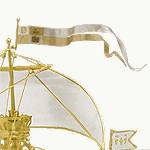 As Luck Would Have It
As Luck Would Have It
In the case of the flags, luck stepped in. Each boat has one white and two tri-color flags on board. Antonio insisted on using only gold and platinum on his ships, so it was a happy coincidence that Spain's colors were red, yellow, and white. These colors could be recreated in red and yellow gold and white platinum. The surfaces of the tri-colored flags appear seamless, as though cut from a single sheet of metal. In fact, they are four separate pieces expertly joined together as one. It is because of small miracles like this that Antonio's work is incomparable.
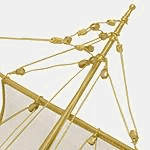 More Than Meets The Eye
More Than Meets The Eye
All the pieces actually holding the ships together - all the pins, nuts, and bolts - are hidden. This makes the ships more attractive, but doubly difficult to construct. The Pinta has 61 pulleys - a considerable number in itself - made up of 262 separate pieces. In all, the Pinta has 1,062 pieces, and the Santa Maria, nearly 1,300. Most of these pieces will never be seen by anyone - except, of course, the artist who put it all together. Trust us: they're there.
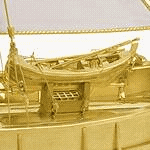 Down To The Last Detail
Down To The Last Detail
The golden ships duplicate the original ships not only in their basic designs but in all accoutrements, as well. The Nina and Pinta, for instance, carried lifeboats - so do Antonio's reproductions. Vents, anchors, flags, pulleys, cannons, ladders, water barrels, and bilge pumps, even the door handle to the captain's cabin can be found onboard. Everything, in fact, but the crew.
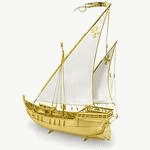
A Defining Difference
Like the Pinta, the Nina was a caravel. Its most striking feature was its lateen sail. Where the other ships had mostly rectangular sails, The Nina's lateen sails were triangular. During the voyage, the Nina reverted to conventional sails, but Antonio has kept the beautiful lateen sails, making this smallest of the three ships especially distinct.

Balancing Act
Gold and platinum have different melting points. This was an important consideration when attaching the gold crosses to the platinum sails. The added instability of different melting points made an already taxing procedure even more difficult. Each sail is less than half a millimeter thick; and because platinum, the purer metal, flexes less than 18K gold under heat, Antonio feared that the cross might pass through the paper-thin sail. The procedure required the utmost care - and then had to be repeated seven times, each sail as vulnerable as the last.
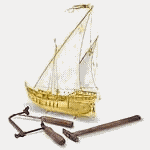 Like Nothing Else
Like Nothing Else
Among art objects, Antonio's ships are utterly unique. Nothing else like them exists. To assess the ships' value, some sort of comparison was necessary; the only example the appraiser could find was an arcane art form, the nef. Nefs were small sailboats, crafted in silver, used as table ornaments. But nefs lack the detail of Antonio's ships, as well as that painstaking adherence to properly proportioned ship design. Besides which, the nef disappeared as an art form hundreds of years ago. We ask of a work of art that it be singular; the Golden Ships of Columbus deliver on that promise.
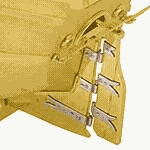 Next Up
Next Up
Half labor of love and half terrible struggle, building the Golden Ships of Columbus is not, one would think, something to be repeated. But, on the contrary, Antonio is upping the ante. His next project, the U.S.S. Constitution, is, if anything, an even more demanding task. Its vast network of sails will be unlike anything ever attempted in gold - and platinum-smithing. The proposed length: one meter. This American frigate will require more than three times the gold and platinum of the other three ships combined. Describing it to us, Antonio held his hands out, as though it were already there. "I can't wait to do it," he said. "I can already see it."
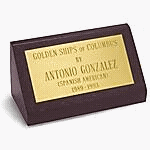 Hasta La Vista
Hasta La Vista
In the end, Antonio fastened the ships into their carrying cases - which he sheathed in cardboard boxes, to make them look less conspicuous on the street - and in a sudden downpour he walked them back to the bank. In Philadelphia, some cops still walk their beats; Antonio found an officer and asked him to make the two-block trip with him, just in case.
The Golden Ships of Columbus are a one-of-a-kind world-class work of art, and this is a purchase few are in the position to even consider. It's our hope that Antonio's ships will finally find their final port.
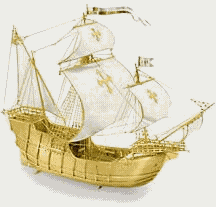
Santa Maria
Dimensions:
18" in length
16.25" in height
3.75" wide*
Weight:
1,258 dwts
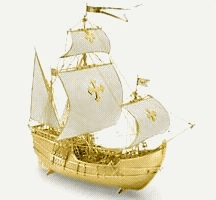
Pinta
Dimensions:
13.75" in length
15 1/8" in height
3.25" in width*
Weight:
799 dwts
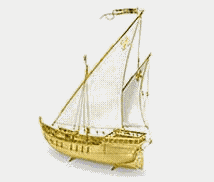
Nina
Dimensions:
16.5" in height
10.5" in length
2.75" in width*
Weight:
685 dwts
It is with great sadness that we announce the passing of Antonio Gonzalez, the master goldsmith and creator of the Golden Ships of Columbus. Antonio passed on July 25, 2005 after a protracted illness
Over view of Project
The Golden Ships of Columbus
Crafted over a four-year period by master goldsmith Antonio Gonzalez, the Golden Ships of Columbus are unlike any other work of art in the world. Antonio worked from actual ship blueprints, using only platinum and 18 kt gold. It required a lifetime's expertise, and the sacrifice of any normal existence, for the artist to realize his project.